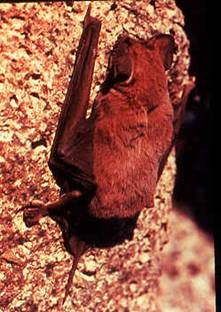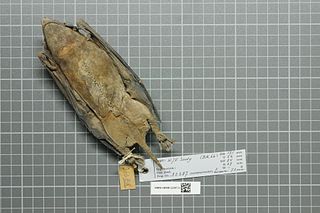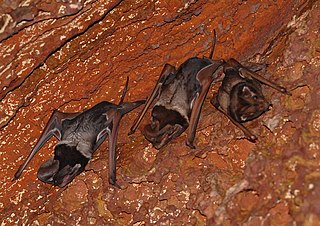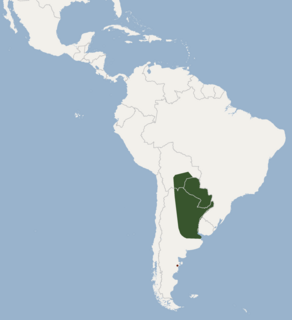
Vespertilionidae is a family of microbats, of the order Chiroptera, flying, insect-eating mammals variously described as the common, vesper, or simple nosed bats. The vespertilionid family is the most diverse and widely distributed of bat families, specialised in many forms to occupy a range of habitats and ecological circumstances, and it is frequently observed or the subject of research. The facial features of the species are often simple, as they mainly rely on vocally emitted echolocation. The tails of the species are enclosed by the lower flight membranes between the legs. Over 300 species are distributed all over the world, on every continent except Antarctica. It owes its name to the genus Vespertilio, which takes its name from a word for bat, vespertilio, derived from the Latin term vesper meaning 'evening'; they are termed "evening bats" and were once referred to as "evening birds".

The bat family Noctilionidae, commonly known as bulldog bats or fishing bats, is represented by two extant species, the greater and the lesser bulldog bats, as well as at least one fossil species, Noctilio lacrimaelunaris, from the Miocene of Argentina. The naked bulldog bat does not belong to this family, but to the family Molossidae, the free-tailed bats. They are found near water, from Mexico to Argentina and also in the Caribbean islands. In these areas they can be found roosting in groups within hollow trees, caves, man made homes, or other openings with enough space. While the two species exhibit different social and foraging behaviors both tend to return to a main roosting spot while also visiting other alternative roosting spots.

The Molossidae, or free-tailed bats, are a family of bats within the order Chiroptera. The Molossidae is the fourth-largest family of bats, containing about 110 species as of 2012. They are generally quite robust, and consist of many strong-flying forms with relatively long and narrow wings with wrinkled lips shared through their genus. Their strong flying forms allows them to fly 60 miles per hour using tail winds and at altitudes over 10,000 feet. This makes them unique among bats, as they are the only bat family that withstands the elevation. They are widespread, being found on every continent except Antarctica. They are typically found in caves, abandoned mines, or tunnels.

The dwarf dog-faced bat is a species of free-tailed bat from South America. It is found in Argentina, Bolivia, Brazil, Colombia, Ecuador, Guyana, Peru, Paraguay and Uruguay, typically at lower elevations. It is one of two species in the genus Molossops, the other being the rufous dog-faced bat. Three subspecies are often recognized, though mammalogist Judith Eger considers it monotypic with no subspecies. It is a small free-tailed bat, with a forearm length of 28.9–32.5 mm (1.14–1.28 in) and a weight of 5–8 g (0.18–0.28 oz); males are larger than females. It is brown, with paler belly fur and darker back fur. Its wings are unusual for a free-tailed bat, with exceptionally broad wingtips. Additionally, it has low wing loading, meaning that it has a large wing surface area relative to its body weight. Therefore, it flies more similarly to a vesper bat than to other species in its own family. As it forages at night for its insect prey, including moths, beetles, and others, it uses two kinds of frequency-modulated echolocation calls: one type is to navigate in open areas and to search for prey, while the other type is used for navigating in cluttered areas or while approaching a prey item.

The Para dog-faced bat, also called the brown dog-faced bat, is a South American bat species of the family Molossidae. It is found in Panama, Colombia, Ecuador, Peru, Venezuela, Guyana, Surinam, French Guiana, Brazil, and northern Argentina.

Ozimops planiceps is a small bat in the family Molossidae, native to Australia and Indonesia.

The lesser naked bat is a species of bat in the family Molossidae, the free-tailed bats. It is native to Indonesia and the Philippines.

The hairless bat, also called the naked bulldog bat and greater naked bat, is a species of bat in the family Molossidae. The generic name Cheiromeles comes from the Greek word cheir and the species name is derived from the Latin torques.

The Egyptian free-tailed bat, also known as Egyptian guano bat or Egyptian nyctinome, is a species of bat in the family Molossidae.

The white-striped free-tailed bat is a species of bat in the family Molossidae. Its echolocation calls are audible to humans, which is a characteristic found in only a few microbat species. The species was formerly classified as Tadarida australis.

The blunt-eared bat or Peruvian crevice-dwelling bat is a species of bat in the family Molossidae. It is monotypic within the genus Tomopeas and subfamily Tomopeatinae. It is endemic to Peru, where it is considered critically endangered. It is threatened by habitat loss.

Wroughton's free-tailed bat is a free-tailed bat formerly considered to be confined to the Western Ghats area of India, though it has also recently been discovered in northeast India and in a remote part of Cambodia. It is classified as a Data Deficient species as nothing much is known about their habitat, ecology and foraging range.

Mops is a genus of bats in the family Molossidae. Molecular sequence data indicates that Mops and Chaerephon are not monophyletic taxa. However, the grouping of Chaerephon and Mops was found to be monophyletic when excluding C. jobimena.

The Patagonian bonneted bat, also called the Patagonian dwarf bonneted bat, is a species of free-tailed bat found in Argentina, Bolivia and Paraguay.

Arixenia esau is a species of earwig, one of three species in the genus Arixenia.

The Florida bonneted bat or Florida mastiff bat is a species of bat in the genus Eumops, the bonneted bats or mastiff bats. Until recently, it was classified as a subspecies of Wagner's bonneted bat . It is endemic to southern Florida in the United States. This species has one of the smallest geographical distributions of any New World bat. It has been called "one of the most critically endangered mammal species in North America". It is protected under the Endangered Species Act.

Eumops ferox, the fierce bonneted bat or the chestnut mastiff bat, is a species of free-tailed bat found in the Caribbean and Mexico. Until recently, it was synonymous with Wagner's bonneted bat.

















